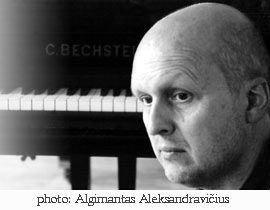The new ballet by Mindaugas Urbaitis, commissioned by the Vilnius Festival 2002, will be premiered on June 28th at the Lithuanian National Opera and Ballet Theater. The stage production of this ballet is developed in cooperation with the Amsterdam-based choreographer Krzysztof Pastor.
 |
In the 1970s Urbaitis created some remarkable minimalist compositions, but since the 1980s he started to construct almost all his works from the music of earlier epochs using it as a certain ready-made material filtered, as it were, through minimalist ears. Urbaitis' re-compositions are not ironic postmodern deconstructions, which have a purpose to discover or thrust on completely new meanings on the chosen music. And the chosen music is not only a source for inspiration, impossible to recognise in the completed piece of music. "I wish that the listeners did not have any doubts about what they hear, that they would not need any explanations", says the composer. To say that he takes delight in diligently constructing his own musical texts out of music already constructed and appreciated by him, would probably be his most apt description of what he actually does.
Having remixed Baroque (Bach), Classicist (Mozart), Romanticist (Bruckner, Wagner, Brahms, Čiurlionis) music and even, Astor Piazolla's tango, this year the composer Mindaugas Urbaitis is one step further - approaching electronic dance music. In his new ballet the composer has decided to adapt to the symphony orchestra what turntable masters are able to generate in dance music clubs today. "In this case, I am not working with texts, literature, but rather with the abstract urban club idea", says the composer about his new piece.
What styles have you chosen to remix this time?Many and of different kind. It has been a year, when I started to collect and listen to large amounts of contemporary electronic dance music - alternative, radical house, hip-hop, drum'n'bass. I have seen ballets using contemporary dance music, I was really impressed. This is all happening with a powerful drive, which interests me in music anyway - the idea of one rhythmic model, on which one can "hang" a long piece. This is also characteristic of my earlier music from the
Trio for three melodic instruments (1981-2), based on the modifications of one rhythmic formula that can be extended to an hour or more.
Apparently you are saying that with your new opus you continue what you have done before?I am not going to run away from myself anywhere. This time I was interested in defining, what is ballet for me. You know that old discussion between Stravinski and Schönberg about their understanding of ballet? Schönberg had said that ballet "is not a musical form", and Stravinski had an opposite view. I support the former, although I worship Stravinski and his scores are lying on my desk all the time. However, I had to come up with something in order to give a shape to the music for ballet. This made me think of what is specific to ballet, or it is possible to write a Violin Concerto (John Adams has done it recently), to which people would dance. But this is not my way. It was the time when I started to understand it more functionally, pragmatically as an applied thing, even if no choreographer is "at hand".
How did you succeed in solving formal problems?I realised my idea similar to what Stravinski does in any of his ballets. The ballet consists of 5-10 minute scenes, connecting into certain groups.
Is there any dramatic line linking them?No, the idea rather reminds the structure of CD tracks, the compositional principle, which I find completely satisfying. This principle is based on the transitions of the orchestration, the coherence of rhythm and consistency of the musical image. Since the opus follows contemporary dance music, I incorporated a group of percussion into the orchestra (Vilnius Percussion Ensemble, directed by Pavelas Giunteris, will participate in the premiere), which has been assigned the principal role. I needed the orchestra only for additional lines, and they are especially rudimentary - hardly a few notes, performed by the huge orchestra. Almost like in Bruckner's symphonies, but the style is completely different. It is the symphonic form of that music that can be interesting and intrigue the listeners. Like a transformation of one style in a completely different space, its translation into the language with different rules, re-arrangement, although here the word 'remixing' would be more appropriate. Usually the concept of remixing is used for those re-arrangements that do not transgress the limits of popular music. In this case, this is a more fundamental re-composition, for, I believe, some reflections of more ancient times, not only from the present epoch and minimalism will emerge.
© Veronika Janatjeva
Lithuanian Music Link No. 4
A full authorized list of Mindaugas Urbaitis' works, biographical dates and discography, illustrated with excerpts from his scores, is available in printed brochure provided on request from the LMIPC.
17 scores of his music are self-published by the composer and can be found online at http://www.sibeliusmusic.com/

